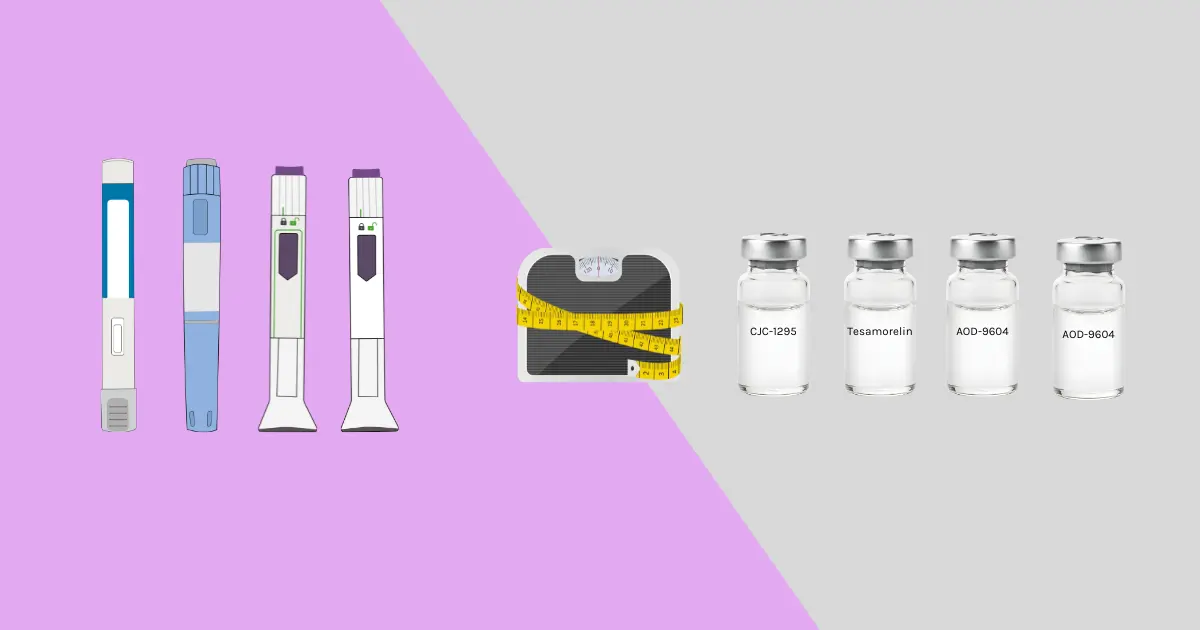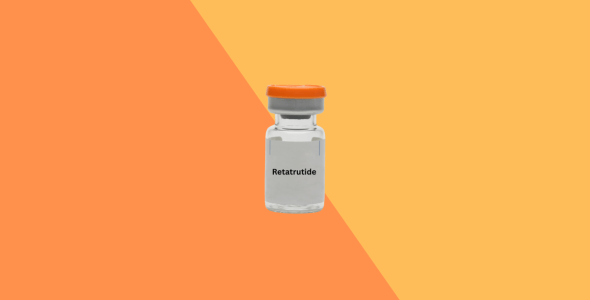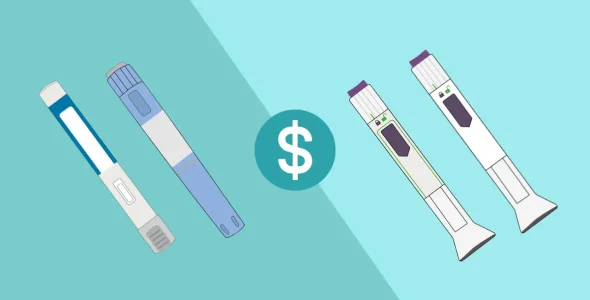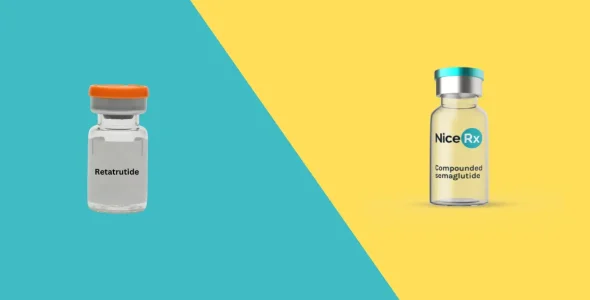Best peptides for weight loss: The complete guide
What if your body's own building blocks held the key to weight loss?
Key highlights
- Peptides are short chains of amino acids and building blocks of proteins, which act as signaling molecules in the body and regulate body metabolism, fat breakdown, and appetite.
- They help reduce body weight by reducing hunger, slowing digestion, boosting metabolism, and improving fat breakdown (lipolysis) while preserving muscle mass.
- Semaglutide, tirzepatide, and liraglutide are FDA-approved GLP-1 peptides that are clinically safe and effective for diabetes and weight management.
- Your healthcare provider may sometimes prescribe non–GLP-1 peptides such as CJC-1295, Ipamorelin, Tesamorelin, AOD-9604, or MOTS-c off-label to help boost metabolism, reduce stubborn fat, and support muscle growth
- Always use a peptide prescribed by your licensed healthcare provider and avoid unregulated sources to ensure safety and effectiveness.
Peptides are short chains of amino acids, which are the building blocks of proteins. They play a crucial role in communication and the functions of the body. They act as signalling molecules that send messages between cells and tissues to perform specific biological functions such as hormone release, tissue repair, fat metabolism, and muscle growth.
Peptide therapy is not a single uniform treatment. The spectrum of peptide therapy ranges from major FDA-approved prescription drugs such as insulin and GLP-1 analogues used to treat diabetes and metabolic disorders, to specialized, off-label compounds for weight management.
Certain peptides, such as GLP-1 analogues, are effective for altering body composition and accelerating fat loss. These include semaglutide, liraglutide, dulaglutide, and tirzepatide. These are FDA-approved for managing weight loss. Additionally, non–GLP-1 peptides for weight loss include CJC-1295, Ipamorelin, Tesamorelin, AOD-9604, or MOTS-c, which are used off-label.
In this article, you will learn about peptides, their mechanism, discover the big three peptides for fat loss, explore integrative options with diet and exercise, and learn long-term strategies to get maximum results.
How do peptides re-engineer your metabolism?
Peptides help your body to re-engineer the metabolism by sending signals to different cells and tissues of the body and regulating their functions.
What is a peptide?
Peptides are short chains of amino acids. Proteins are long and complex structures, while peptides are smaller and are made up of 2-50 amino acids that are linked together via peptide bonds. Peptides act as messengers (signalling molecules) that send signals to cells and tissues of the body to regulate their functions, such as releasing insulin, burning fat, or delaying digestion.
The weight loss mechanism
Think of peptides like a key that fits into a specific lock in your body. Each peptide is designed to unlock the specific function in your body. When the right peptide binds with the right receptor, it triggers a specific function, such as releasing hormones, burning fat, or increasing metabolism.
The weight loss mechanism of the peptide is as follows:
Appetite regulation and satiety
Some peptides mimic the activity of natural hormones that send signals of fullness to your brain. This helps reduce constant hunger noise (food cravings) and allows you to eat less and more mindfully.
Slowed gastric emptying
Peptides slow down digestion by reducing peristaltic contractions of your stomach. The food stays in your stomach for a longer time. Slow gastric emptying makes you feel full between meals and keeps your blood sugar levels stable.
Metabolic switch and fat breakdown (lipolysis)
Peptides can directly influence how your body uses and burns fat. They either send signals to your adipose tissues to release stored fat to provide energy or release growth hormones, which boost fat metabolism.
The primary mechanisms of action
The primary mechanisms of action of peptides are:
Boost metabolism
Peptides boost your body’s metabolism, which helps you burn more calories even at rest. They make your metabolism more efficient and support weight loss.
Increase growth hormone release
Peptides stimulate your body to produce more growth hormone, a key hormone that regulates metabolism, muscle growth, and fat burning. When the growth hormone level rises in your body, it shifts your body into fat-burning mode. This hormone helps break down stored fat (lipolysis) to provide energy to your body, which leads to weight loss. At the same time, it also preserves lean muscle mass, which further boosts the metabolism.
Mimic satiety hormones
Some peptides, such as GLP-1 agonists (glucagon-like peptide 1), mimic the activity of natural hormones, which help regulate hunger and digestion. When the peptide activates GLP-1 receptors in the brain and digestive system, it sends signals of fullness to the brain and slows down your gastric emptying, which makes you feel satiated with less food and helps in weight loss.
Target stubborn fat areas
Peptides are believed to interact with the specific receptors (alpha-2 receptors) that are located in the stubborn fat areas, such as the abdomen and thighs. Normally, these receptors (alpha-2) block the release of fat, which is why some areas are harder to slim down. By targeting these receptors, peptides promote fat breakdown in these resistant zones.
The top 3 FDA-approved GLP-1 peptides for weight loss
The following are the top 3 FDA-approved GLP-1 peptides for weight loss.
1. Semaglutide (Wegovy and Ozempic): Weekly GLP-1 injection
Semaglutide is an FDA-approved GLP-1 receptor agonist that mimics the activity of the natural hormone GLP-1, which regulates hunger and appetite. By activating GLP-1 receptors, semaglutide suppresses appetite, reduces hunger cravings, and lowers calorie intake. Semaglutide is marketed as Ozempic for managing blood sugar levels (with weight loss as an off-label benefit) and Wegovy for weight loss.
Semaglutide is best for those who struggle with constant hunger and intense cravings. This medication helps reduce the discomfort and decrease food intake, making it easier for patients to maintain healthy eating habits and achieve long-term results.
2. Tirzepatide (Zepbound and Mounjaro): Weekly GLP-1/GIP injection
Tirzepatide is a dual GLP-1 and GIP receptor agonist that mimics the activity of two natural hormones, glucagon-like peptide-1 and glucose-dependent insulinotropic polypeptide, that regulate your appetite and metabolism. Like GLP-1 receptor agonists, this medication also works by sending satiety signals to your brain to reduce appetite and delay gastric emptying. Additionally, it occupies GIP receptors and mimics the action of the GIP hormone to enhance insulin release and promote fat breakdown. Tirzepatide is sold under two brand names, Zepbound for weight loss and Mounjaro for blood sugar control. Mounajro can also be used for weight loss (off-label).
This medication is best for people with obesity and overweight who want to reduce body weight, control blood sugar in patients with type 2 diabetes, and manage weight-related complications such as moderate to severe obstructive sleep apnea.
3. Liraglutide (Victoza and Saxenda): Daily GLP-1 injection
Liraglutide (sold as Sexenda for diabetes and Victoza for weight loss) is a daily GLP-1 injection that helps lower your blood sugar level and reduce hunger. Liraglutide is the first drug in this class approved by the FDA and is considered the predecessor to new GLP-1 medications.
Liraglutide is effective for weight loss and blood sugar control, but is less potent than newer GLP-1 medications such as semaglutide (Ozempic, Wegovy, and Rybelsus) and tirzepatide (Mounjaro and Zepbound), which provide greater weight loss and better sugar control.
The top 5 non-GLP-1 peptides for weight loss and fat burning
Non-GLP-1 peptides are compounds that are generally used in specialized clinics and may help improve your metabolism, support fat loss, and enhance body composition in conjunction with a healthy diet and exercise. These compounds are not approved by the U.S Food and Drug Administration (FDA) for weight loss, but healthcare providers prescribe these compounds off-label for weight loss and improving metabolic health.
Here are the top 5 best peptides for weight loss and fat burning.
1. CJC-1295 and Ipamorelin: Growth hormone boosters
CJC-1295 and ipamorelin are synthetic therapeutic peptides called growth hormone secretagogues (GHS). CJC-1295 mimics the activity of growth hormone-releasing hormone (GHRH) and signals your pituitary gland to release more growth hormone (GH) over a sustained period, and increases its levels in the body.
According to a study, after a single injection of CJC-1295, mean plasma growth hormone concentrations increased dose-dependently by 2- to 10-fold for 6 days or longer, and mean plasma IGF-I concentrations increased by 1.5- to 3-fold for 9–11 days. The estimated half-life of CJC-1295 was 5.8–8.1 days. Following multiple doses, mean insulin-like growth factor (IGF-1) levels remained above baseline for up to 28 days. No serious adverse reactions were reported.
Ipamorelin is a synthetic analog of ghrelin, a natural hormone produced in the stomach. It works by binding to ghrelin receptors in the brain, which stimulates the pituitary gland to release growth hormone (GH). Unlike many other GH-releasing compounds, Ipamorelin does not elevate cortisol levels in your body, which is a primary stress hormone that negatively affects body weight.
Growth hormones promote protein synthesis that helps build and repair muscle tissue. When you have a high level of growth hormone, your muscles recover faster after exercise and become stronger over time.
Growth hormone plays an essential role in fat metabolism by stimulating lipolysis (the breakdown of stored fat into energy). Elevated levels of growth hormone enhance your body’s ability to burn fat more efficiently, leading to a gradual reduction in body fat over time, especially in stubborn, fat-resistant areas. This process not only supports weight loss but also helps improve overall body composition, making the body leaner and improving physique.
Growth hormone is naturally released during deep sleep. The CJC-1295 and Ipamorelin combination supports your body’s natural growth hormone rhythm, helping enhance sleep quality, speed recovery, and boost overall energy levels.
The CJC-1295 and Ipamorelin combination is best for individuals aiming to lose fat and gain lean muscle. It helps increase metabolism, enhance muscle recovery, and improve body tone by naturally boosting the secretion of growth hormone levels. This makes it a great option for individuals who want a leaner, stronger, and more balanced physique.
2. Tesamorelin: Stubborn fat specialist
Tesamorelin is a synthetic analog of growth hormone-releasing hormone (GHRH), a natural hormone secreted by the hypothalamus that targets the pituitary glands to secrete growth hormone. When Tesamorelin binds with the GHRH receptor in the pituitary glands, it stimulates the release of the growth hormone that sends signals to the liver to produce insulin-like growth factor-1 (IGF-1). Insulin-like growth factor-1 regulates body metabolism, tissue repair, and fat breakdown. Most importantly, this hormone promotes lipolysis and targets visceral fat in your abdomen (fat that surrounds your internal organs, which is hard to lose).
In a 12-month clinical trial involving 404 HIV-infected patients with excess abdominal fat, Tesamorelin (2 mg daily) significantly reduced visceral adipose tissue (VAT) compared to placebo. After 6 months, patients taking Tesamorelin showed an 18% reduction in visceral fat (about −21 cm²) on average compared to almost no reduction in the placebo group.
The treatment also led to improvements in waist circumference, waist-to-hip ratio, and body image, without affecting blood sugar levels or causing major side effects. However, when patients stopped taking Tesamorelin, the fat reduction benefits were quickly reversed, suggesting that continued use is necessary to maintain results.
Tesamorelin is best for individuals who struggle with stubborn belly fat that doesn’t go away even with a healthy diet and regular exercise.
3. AOD-9604: Metabolic enhancer
AOD-9604 is a modified fragment derived from the C-terminal (176-191) portion of human growth hormone (HGH) that works directly on the fat cells without affecting muscle growth and blood sugar levels. It works by acting directly on fat cells, stimulating lipolysis (the breakdown of stored fat) and inhibiting lipogenesis (the formation of new fat).
Unlike regular HGH, AOD-9604 does not raise IGF-1 levels or promote growth of tissues and organs, making it a safe option for those who want the fat-burning benefits of human growth hormone without unwanted side effects.
AOD-9604 is best for individuals looking to boost metabolism, enhance fat loss, and support weight management goals. It is often stacked with other peptides, such as CJC-1295 or Ipamorelin, to maximize fat-burning and improve body composition results.
4. MOTS-c: The cellular energy optimizer
MOTS-c (mitochondrial open reading frame of the 12S rRNA type-c) is a mitochondrial-derived peptide produced from DNA inside the mitochondria that helps regulate energy and improve metabolic homeostasis at the cellular level. It works by improving insulin sensitivity, activating AMPK (an enzyme that boosts fat burning), and enhancing mitochondrial function to increase overall energy production. These actions make your body more efficient at using fat fuel, improve exercise capacity, and help counteract age-related and diet-induced obesity.
MOTS-c is best for people focused on longevity, energy optimization, and metabolic health, especially those who want to overcome age-related fatigue, weight gain, or insulin resistance. It is considered one of the most advanced peptides in the field of anti-aging and cellular rejuvenation.
5. Lipotropic injection
Lipotropic injections are a combination of B vitamins and amino acids, typically methionine, inositol, and choline, that work together to support liver function and enhance fat metabolism. These nutrients help the liver break down and remove fat more efficiently, prevent fat buildup and promote steady energy levels.
Peptide comparison chart: Which one is right for you?
Here is a comparison of the best peptides for weight loss:
GLP-1 peptides comparison
| Peptide Name | Brand Name | Type / Class | Mechanism of Action | FDA-Approved Uses | Dosing Frequency | Route of Administration |
|---|---|---|---|---|---|---|
| Semaglutide | Ozempic | GLP-1 receptor agonist | Mimics GLP-1 hormone activity to increase insulin secretion, suppresses glucagon secretion, slows digestion, and reduces appetite. | Blood sugar control in adults with type 2 diabetes, cardiovascular risk reduction (heart attack, stroke, death) and to lower the risk of kidney disease progression in CKD patients. | Once weekly | Subcutaneous injection |
| Rybelsus | GLP-1 receptor agonist (oral) | Acts on GLP-1 receptors in the pancreas and gut to increase insulin secretion, decrease glucagon, slow gastric emptying, and promote fullness. | Blood sugar control in adults with type 2 diabetes. | Once daily | Oral tablet | |
| Wegovy | GLP-1 receptor agonist | Stimulates GLP-1 receptors in the gut and brain to reduce appetite, slow digestion, and regulate hunger signals. | Chronic weight management in adults (BMI ≥30 or ≥27 with comorbidity) and adolescents ≥12 years with obesity, to reduces cardiovascular risk in adults with obesity and heart disease. | Once weekly | Subcutaneous injection | |
| Tirzepatide | Mounjaro | Dual GIP & GLP-1 receptor agonist | Activates both GIP and GLP-1 receptors to enhance insulin secretion, reduce appetite, and improve fat metabolism. | Improves blood sugar control in adults with type 2 diabetes. | Once weekly | Subcutaneous injection |
| Zepbound | Dual GIP & GLP-1 receptor agonist | Activates both GIP and GLP-1 receptors to enhance insulin secretion, reduce appetite, improve fat metabolism, and promote weight loss. | Chronic weight management in adults (BMI ≥30, or ≥27 with comorbidity such as hypertension, diabetes, or dyslipidemia), management of moderate to severe obstructive sleep apnea in adults with obesity. | Once weekly | Subcutaneous injection | |
| Liraglutide | Victoza | GLP-1 receptor agonist | Increases insulin secretion, decreases glucagon release, slows gastric emptying, and reduces appetite. | Glycemic control in adults and children ≥10 years with type 2 diabetes, cardiovascular risk reduction in adults with type 2 diabetes and heart disease. | Once daily | Subcutaneous injection |
| Saxenda | GLP-1 receptor agonist | Increases insulin secretion, decreases glucagon, slows gastric emptying, and reduces appetite. | Chronic weight management in adults and adolescents ≥12 years with obesity (≥60 kg). | Once daily | Subcutaneous injection | |
| Dulaglutide | Trulicity | GLP-1 receptor agonist | Stimulates insulin release, suppresses glucagon, and delays digestion to lower blood sugar. | Improves glycemic control in adults and children ≥10 years with type 2 diabetes and reduce cardiovascular risk in adults with type 2 diabetes and established or high-risk heart disease. | Once weekly | Subcutaneous injection |
Non-GLP-1 peptides comparison
| Peptide Name | Primary Mechanism | Key Benefit | Best For | Injection Frequency |
|---|---|---|---|---|
| CJC-1295 + Ipamorelin | Stimulates natural growth hormone release (GHRH + GHRP synergy) | Increases lean muscle, improves recovery, enhances sleep, boosts fat loss | Anti-aging, body composition, performance | 1x daily or 5x per week |
| Tesamorelin | GHRH analog that increases endogenous GH and IGF-1 | Reduces visceral fat (especially abdominal), improves metabolism | Belly fat reduction, metabolic health | Daily |
| AOD-9604 | Fragment of human growth hormone targeting fat metabolism | Promotes fat burning without affecting blood sugar or growth | Weight loss, fat metabolism | Daily |
| 5-Amino-1MQ (Lipotropic peptide) | Inhibits NNMT enzyme to improve fat metabolism | Boosts energy, supports fat breakdown, may enhance muscle tone | Fat loss, metabolic support | Daily or every other day |
| MOTS-c | Mitochondrial peptide that enhances cellular metabolism | Increases energy, improves exercise performance, supports longevity | Energy, endurance, anti-aging | 2–3x per week |
| Lipotropic Injection (MIC: Methionine, Inositol, Choline + B12) | Enhances liver fat metabolism and supports energy conversion | Assists fat loss, improves energy, supports liver detox | Weight management, energy support | 1–2x per week |
Emerging peptide therapies
New peptide medications are being developed to help with weight loss, blood sugar control, and overall metabolic health. These medications offer better results than current drugs like semaglutide and tirzepatide. Two of the most promising new options being studied are Retatrutide and MariTide.
Retatrutide
Retatrutide is a powerful new weight-loss medication developed by Eli Lilly. Unlike other treatments such as semaglutide and tirzepatide, which act on only one or two receptors, Retatrutide is a triple receptor agonist. It targets three key receptors, GLP-1, GIP, and GCG (glucagon).
By activating all three receptors, Retatrutide helps increase insulin secretion, suppress glucagon, improve fat metabolism, reduce appetite, and enhance overall metabolic health. This multi-receptor approach not only supports better blood sugar control but also promotes greater fat loss and improved metabolic efficiency.
In clinical studies, participants taking Retatrutide experienced up to 24% weight loss over 48 weeks, more than observed with current GLP-1 treatments. Early data also suggest its benefits for lowering cholesterol levels, liver fat reduction, and cardiovascular health protection. Retatrutide is currently in phase 3 clinical trials and has not yet been approved by the FDA.
MariTide
MariTide (Maridebart Cafraglutide) is an emerging peptide developed by Amgen. It represents a new class of weight-loss medications and has a unique mechanism of action.
Unlike other drugs such as Mounjaro and Zepbound, which activate both GLP-1 and GIP receptors, MariTide works as a GLP-1 receptor agonist and a GIP receptor antagonist. This means it stimulates GLP-1 receptors to reduce appetite and enhance insulin secretion, while blocking GIP signaling, which may help prevent fat storage.
In phase 2 clinical trials, people with obesity who used MariTide achieved up to 20% weight loss after one year, along with significant improvements in blood sugar levels and other metabolic markers.
Another exciting feature of MariTide is its long-acting formulation, which requires only one injection per month, making it more convenient than current once-weekly options. MariTide has not been approved by the FDA yet and is currently in Phase 3 clinical trials.
Safety and side effects
Peptides can offer significant health benefits, but like any other biologically active therapy, they can cause some side effects. However, these side effects are temporary and resolve on their own as your body adjusts. The most common side effects include:
- Injection site reactions: It is common to experience mild redness, swelling, or itching on the injection site.
- Gastrointestinal symptoms: Some peptides, especially GLP-1 receptor agonists such as semaglutide or tirzepatide, can slow digestion, which may lead to nausea, vomiting, diarrhea, or constipation. They usually occur in the initial phase of starting the treatment or during dose escalation, but improve over time.
- Increase hunger: Peptides like CJC-1295, Ipamorelin, or Tesamorelin stimulate the release of growth hormones, which can temporarily increase appetite during the first few weeks of use. This occurs because growth hormones can influence metabolic rate and blood sugar regulation. These effects usually subside on their own as your hormone levels balance.
- Water retention or mild bloating: Small amounts of fluid retention can occur when starting peptide analogues of growth hormone because growth hormone causes sodium and water retention in the tissues, resulting in slight puffiness or bloating. It typically resolves as your body adapts.
- Carpal tunnel-like symptoms: Peptides that increase the secretion of growth hormone may cause mild tingling, numbness, or tightness in the wrists or hands (similar to carpal tunnel syndrome). These symptoms occur due to fluid shift and pressure on the nerves, which usually improve with dose adjustment or taking short breaks after consulting with your healthcare provider.
There are some serious risks associated with the GLP-1 receptor agonists. These include the following:
- Thyroid C-Cell Tumors (Medullary thyroid carcinoma, MTC). GLP-1 receptor agonists carry a boxed warning. Avoid using GLP-1 RAs if you have a personal or family history of medullary thyroid carcinoma or MEN2 syndrome (Multiple endocrine neoplasia type 2 syndrome).
- Pancreatitis and gallbladder issues: Severe abdominal pain that radiates to the back, nausea, fever, or vomiting while using GLP-1s may indicate inflammation of the pancreas, while upper right abdominal pain, jaundice, fever, and nausea can be due to gallbladder issues such as gallstones. Stop the medication if you are experiencing these symptoms and consult with your healthcare provider before taking the next dose.
- Gastrointestinal complications (gastroparesis): GLP-1 medications slow digestion by delaying stomach emptying. This effect can cause or worsen gastroparesis. Symptoms include nausea, bloating, or feeling full quickly. If these symptoms persist, consult with your healthcare provider.
Peptide therapies that stimulate the secretion of growth factors like CJC-1295, Ipamorelin, and Tesamorelin should be used cautiously in individuals with a history of cancer or uncontrolled tumor growth because these peptides may influence cell proliferation.
The high demand for semaglutide and tirzepatide has led to an increase in the availability of many non-FDA-approved compounded peptides. These unregulated versions may carry safety risks and impurities, and reduce their effectiveness. The FDA has issued multiple warnings about these products because of:
- Unknown quality
- Incorrect or impure ingredient (salt forms)
- Lack of sterility
- Incorrect dosing
- Risk of contamination
Therefore, only use FDA-approved peptides or get your medication from a certified healthcare provider or a 503a compounding pharmacy. Make sure that your clinic or pharmacy works with reputable, high-quality compounding pharmacies that follow strict safety protocols.
How to use peptides safely: Protocols, dosage, and administration
Peptide therapy can offer significant health and weight-loss benefits, but its safety is essential. Follow these protocols to ensure safety:
Medical supervision
Always consult a licensed healthcare provider who can first evaluate your health condition, discuss your goals, take a detailed medical history, and determine which peptide is best for you. Afterwards, they will prescribe the correct dosage, frequency, and duration of the medication and monitor your progress to ensure safety and effectiveness.
Typical administration
Mostly, peptides are administered via a subcutaneous route (under the skin). Common injection sites include the abdomen, thigh, or upper arm. Many peptides follow a cycling protocol, which means you take peptides for some period (on cycle) and then take a break (off-cycle). This helps your body stay active and prevents receptor desensitization.
The critical importance of sourcing
Quality, safety, and efficacy of the product depend heavily on where they come from. Avoid using black-market and research-grade peptides that are sold online, as they are often unregulated, contaminated, or incorrectly dosed, which can affect your health.
Ensure that your peptides are sourced from a licensed 503a compounding pharmacy that conducts third-party testing for purity and sterility.
Prescription, cost, and long-term weight management
Do I need a prescription?
Yes, all credible peptide therapies for weight loss and blood sugar control require a prescription from a licensed healthcare professional. These are not over-the-counter medications and should be used under the supervision of your healthcare professional to ensure safety and effectiveness. The eligibility criteria for most FDA-approved weight loss drugs are as follows:
- Body mass index (BMI) of 30 or higher (classified as obesity)
- Body mass index (BMI) of 27 or higher (classified as overweight) with one weight-related health condition, such as hypertension, hyperlipidemia, heart disease, and high blood cholesterol levels.
The cost
Peptide-based weight loss drugs are expensive, with an average list price of $1,000-$1,350 per month. However, the actual cost of the medication varies depending on the dose, your insurance coverage, the pharmacy, and your location. You can manage these expenses in the following ways:
- Insurance coverage: Some healthcare insurance plans may cover part of the cost or sometimes the full cost of the medication if you meet their eligibility criteria. It is better to verify with your insurance provider whether they cover the peptide therapy you have chosen.
- Manufacturer savings programs: Many drug manufacturers offer discount cards, coupons, and patient assistance programs (PAP) to help reduce the cost of eligible patients. You can check the Mounjaro savings card, Ozempic savings card, Wegovy savings card, and Zepbound savings card or consider using the self-pay option provided by LillyDirect (Eli Lilly) or NovoCare Pharmacy (Novo Nordisk).
- Specialized clinics: Some medical or weight-loss clinics offer membership programs and treatment packages to make peptide therapy more affordable for eligible patients. Ask your clinician about these programs.
Maintenance
Peptides like semaglutide and tirzepatide are effective tools for weight loss when used for long-term treatment. Studies show that many people tend to regain weight after stopping semaglutide. In the STEP-4 clinical trials, participants who discontinued the medication began to regain weight within a few months. This happens because when you stop the treatment, the effects of medication, such as reduced appetite and slower digestion, gradually fade and lead to an increase in hunger cravings and higher calorie intake. Weight loss results depend on your consistency, along with consistent lifestyle changes such as a healthy diet, regular exercise, and increased physical activity.
Frequently asked questions
How fast will I see results with peptides?
Weight loss with peptides is not an overnight process. Most patients experience visible changes in their body composition after about 2-3 months of consistent use. However, the overall timeline varies depending on the type of peptide, your diet, sleep routine, exercise, and overall lifestyle. Therefore, setting realistic expectations and staying consistent helps you achieve lasting results.
Can I stack peptides for better results?
Yes, peptides can be stacked for better results, but only under the supervision of your healthcare provider. Some common combinations for stacking include CJC-1295 + Ipamorelin to support growth hormone release or AOD-9604 + GLP-1 protocol to boost fat metabolism. A qualified doctor can create a personalized synergistic plan and dosing schedule to ensure safety and achieve maximum results.
Are peptides for weight loss FDA-approved?
Most peptides that are used for weight loss purposes are not FDA-approved. Their use is mainly off-label. However, some peptides, such as semaglutide and tirzepatide, are FDA-approved for weight loss under brand names Wegovy and Zepbound, respectively. Other peptides are prescribed legally as compounded medications through specialized clinics to support weight loss. Always use these medications after getting a valid prescription from a licensed healthcare professional.
Are oral peptides effective?
Oral peptides are generally not effective for weight loss. Most peptides are broken down in the digestive system before they enter the bloodstream, which makes them ineffective when taken orally. Injectable peptides are the standard option because they have greater bioavailability and efficacy than oral treatments.
Conclusion: Using peptides as a powerful tool for weight loss
Peptides represent a significant advancement in weight management by targeting the root cause of metabolic imbalance. They work by regulating appetite, improving fat metabolism, enhancing energy use, and preserving lean muscle.
It is important to remember that peptides are not a substitute for a healthy lifestyle. These tools can accelerate your results when combined with a balanced diet, regular exercise, healthy sleep habits, and behavioral support. However, the overall results depend on the consistency of treatment and maintaining healthy lifestyle habits.
Peptides are significantly effective, but they should be used carefully under the guidance of experienced healthcare providers. Always start peptide therapy after getting a valid prescription from your healthcare provider. Whether you choose the prescription route (GLP-1s) or an integrative approach (AOD-9604, GHRPs), get a personalized dosing schedule to ensure safety and long-term effectiveness.
Consult with a qualified medical professional who can help you determine if peptide therapy is a safe and appropriate path for your health goals.




